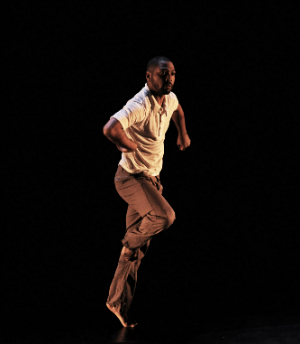Kyle Abraham has ridden into Dublin on a huge wave of anticipation. The rising star, originally from Pittsburgh, is the talk of the New York dance scene at present, having received a prestigious Bessie award for his piece The Radio Show and been recently commissioned to create work for the well-known Alvin Ailey company. The performer has come to Ireland, under the aegis of John Scott Dance (formerly Irish Modern Dance Theatre), to develop and present a piece with four of the company’s performers (Philip Connaughton, Liv O’Donoghue, Ryan O’Neill, and Rebecca Reilly).
Abraham has described his style of dance as a ‘postmodern gumbo’, referring to the mix of genres that filter through in his choreography. In conversation, he says it’s ‘all movement’ to him, but underneath this simplification of the diverse dance vocabulary he can so readily lay his hands on there is an astute awareness of the formal training he has received and the need to acknowledge the dance heritage he draws on in his work.
 Abraham’s work for John Scott Dance premiered in the Space Upstairs at Project Arts Centre on Monday night, the main work Outsider bookended by two of the choreographer’s own solos. Outsider itself has had a long and somewhat sporadic gestation period; conceived two years ago by Abraham and developed with a cast of six, the current realisation of the piece stems from a relatively short residency with four of the original performers in which the colour and feel of the piece moved quite far away from its original tone. “Things shifted,” says Abraham, in reference to this movement.
Abraham’s work for John Scott Dance premiered in the Space Upstairs at Project Arts Centre on Monday night, the main work Outsider bookended by two of the choreographer’s own solos. Outsider itself has had a long and somewhat sporadic gestation period; conceived two years ago by Abraham and developed with a cast of six, the current realisation of the piece stems from a relatively short residency with four of the original performers in which the colour and feel of the piece moved quite far away from its original tone. “Things shifted,” says Abraham, in reference to this movement.
The current version of the work shows evidence of this recent shift, lacking cohesion. Soundtracked primarily by indie-rock band People Get Ready, interspersed with Smokey Robinson, the piece begins in a club setting, the four dancers dressed in poppy colours, matching the poppy soundtrack. They segue in and out of dance phrases, beginning unison sections that quickly unravel as they walk away, before re-grouping. At times, one or other of the performers stands apart from the others, the token outsider.
These are four very strong performers in their own right; in particular, Liv O’Donoghue delivered an effortlessly graceful performance, while Philip Connaughton provided some deftly-timed humour with his comic monologue. However, although containing some interesting and well-executed dance, the direction of the piece overall is unclear, the different elements hanging loosely together rather than being convincingly woven. The original roots of the work are evident; some sections, in particular a scene where dancer Ryan O’Neill plays dead and Rebecca Reilly screams piercingly over his body while O’Donoghue and Connaughton have an awkward chat to one side, indicate an interesting tension that isn’t fully exploited in the work as a whole.
When queried about the connection between his two solos and Outsider, Abraham says it’s ironic “that what [he’s] showing as a solo artist still falls into the title [Outsider]”. There is a much stronger sense of purpose about these shorter pieces. The second of the two, Live! The Realest MC, an excerpt from a longer work, is Abraham’s take-off of the macho bravado inherent in hip-hop culture and is a mixture of chuckle-inducing satire and a more unnerving examination of the insecurities that can be hidden behind such male posturing.
However, the first solo of the night was also the most honest performance of the evening. Ne Me Quitte Pas, a piece performed to Nina Simone's version of song, grew out of Abraham’s reaction to a retrospective of visual artist Carrie Mae Weem’s work, in particular her self-portraits. Abraham describes them as communicating a sense of ‘romantic isolation’ and the depth of feeling with which he speaks of how her images moved him comes through strongly in the performance. His virtuosity as a dancer is evident here and the startling range of styles he seamlessly transitions between attest to the furore currently surrounding him. His dancing exhibits total control and the intelligent detail in the choreography communicates an affecting depth of feeling. Throughout the solo, Abraham oscillates between grandiose gestures and then diminished echoes of these gestures, incorporating repeated nuances like hands uncertainly searching for pockets that fit a narrative around the solo.
Abraham’s capability, originality and assuredness as a performer are indisputable, although his ability to transfer this talent to his work as a choreographer was not entirely borne out by Outsider. However, there are hints here of a keen choreographic sensibility and, undoubtedly, greatness to come.
Rachel Donnelly is a Dublin-based freelance writer and editor